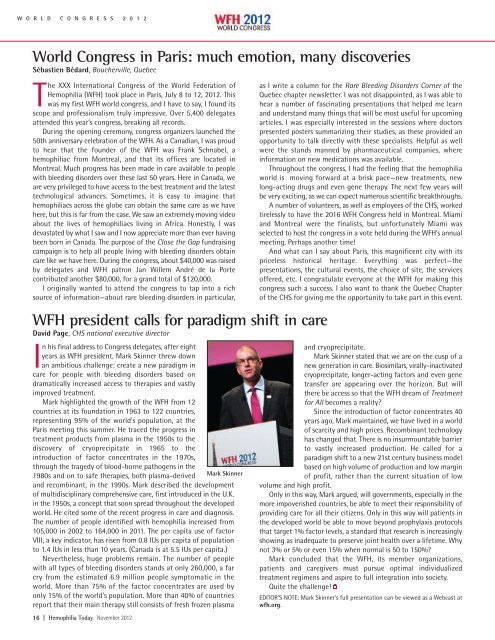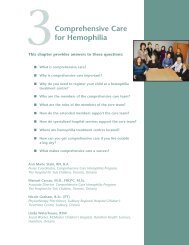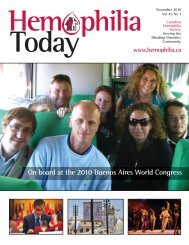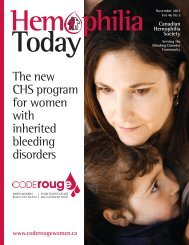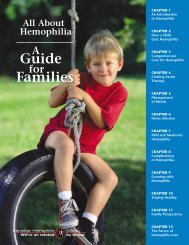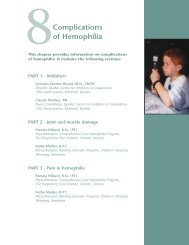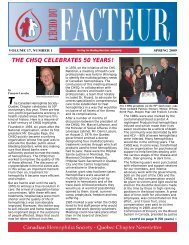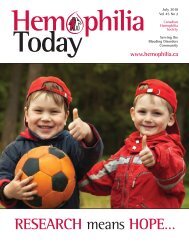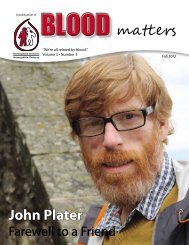Canadian Hemophilia Society
Canadian Hemophilia Society
Canadian Hemophilia Society
Create successful ePaper yourself
Turn your PDF publications into a flip-book with our unique Google optimized e-Paper software.
W O R L D C O N G R E S S 2 0 1 2<br />
World Congress in Paris: much emotion, many discoveries<br />
Sébastien Bédard, Boucherville, Quebec<br />
The XXX International Congress of the World Federation of<br />
<strong>Hemophilia</strong> (WFH) took place in Paris, July 8 to 12, 2012. This<br />
was my first WFH world congress, and I have to say, I found its<br />
scope and professionalism truly impressive. Over 5,400 delegates<br />
attended this year’s congress, breaking all records.<br />
During the opening ceremony, congress organizers launched the<br />
50th anniversary celebration of the WFH. As a <strong>Canadian</strong>, I was proud<br />
to hear that the founder of the WFH was Frank Schnabel, a<br />
hemophiliac from Montreal, and that its offices are located in<br />
Montreal. Much progress has been made in care available to people<br />
with bleeding disorders over these last 50 years. Here in Canada, we<br />
are very privileged to have access to the best treatment and the latest<br />
technological advances. Sometimes, it is easy to imagine that<br />
hemophiliacs across the globe can obtain the same care as we have<br />
here, but this is far from the case. We saw an extremely moving video<br />
about the lives of hemophiliacs living in Africa. Honestly, I was<br />
devastated by what I saw and I now appreciate more than ever having<br />
been born in Canada. The purpose of the Close the Gap fundraising<br />
campaign is to help all people living with bleeding disorders obtain<br />
care like we have here. During the congress, about $40,000 was raised<br />
by delegates and WFH patron Jan Willem André de la Porte<br />
contributed another $80,000, for a grand total of $120,000.<br />
I originally wanted to attend the congress to tap into a rich<br />
source of information—about rare bleeding disorders in particular,<br />
as I write a column for the Rare Bleeding Disorders Corner of the<br />
Quebec chapter newsletter. I was not disappointed, as I was able to<br />
hear a number of fascinating presentations that helped me learn<br />
and understand many things that will be most useful for upcoming<br />
articles. I was especially interested in the sessions where doctors<br />
presented posters summarizing their studies, as these provided an<br />
opportunity to talk directly with these specialists. Helpful as well<br />
were the stands manned by pharmaceutical companies, where<br />
information on new medications was available.<br />
Throughout the congress, I had the feeling that the hemophilia<br />
world is moving forward at a brisk pace—new treatments, new<br />
long-acting drugs and even gene therapy. The next few years will<br />
be very exciting, as we can expect numerous scientific breakthroughs.<br />
A number of volunteers, as well as employees of the CHS, worked<br />
tirelessly to have the 2016 WFH Congress held in Montreal. Miami<br />
and Montreal were the finalists, but unfortunately Miami was<br />
selected to host the congress in a vote held during the WFH’s annual<br />
meeting. Perhaps another time!<br />
And what can I say about Paris, this magnificent city with its<br />
priceless historical heritage. Everything was perfect—the<br />
presentations, the cultural events, the choice of site, the services<br />
offered, etc. I congratulate everyone at the WFH for making this<br />
congress such a success. I also want to thank the Quebec Chapter<br />
of the CHS for giving me the opportunity to take part in this event.<br />
WFH president calls for paradigm shift in care<br />
David Page, CHS national executive director<br />
In his final address to Congress delegates, after eight<br />
years as WFH president, Mark Skinner threw down<br />
an ambitious challenge: create a new paradigm in<br />
care for people with bleeding disorders based on<br />
dramatically increased access to therapies and vastly<br />
improved treatment.<br />
Mark highlighted the growth of the WFH from 12<br />
countries at its foundation in 1963 to 122 countries,<br />
representing 95% of the world’s population, at the<br />
Paris meeting this summer. He traced the progress in<br />
treatment products from plasma in the 1950s to the<br />
discovery of cryoprecipitate in 1965 to the<br />
introduction of factor concentrates in the 1970s,<br />
through the tragedy of blood-borne pathogens in the<br />
1980s and on to safe therapies, both plasma-derived Mark Skinner<br />
and recombinant, in the 1990s. Mark described the development<br />
of multidisciplinary comprehensive care, first introduced in the U.K.<br />
in the 1950s, a concept that soon spread throughout the developed<br />
world. He cited some of the recent progress in care and diagnosis.<br />
The number of people identified with hemophilia increased from<br />
105,000 in 2002 to 164,000 in 2011. The per capita use of factor<br />
VIII, a key indicator, has risen from 0.8 IUs per capita of population<br />
to 1.4 IUs in less than 10 years. (Canada is at 5.5 IUs per capita.)<br />
Nevertheless, huge problems remain. The number of people<br />
with all types of bleeding disorders stands at only 260,000, a far<br />
cry from the estimated 6.9 million people symptomatic in the<br />
world. More than 75% of the factor concentrates are used by<br />
only 15% of the world’s population. More than 40% of countries<br />
report that their main therapy still consists of fresh frozen plasma<br />
16 | <strong>Hemophilia</strong> Today November 2012<br />
and cryoprecipitate.<br />
Mark Skinner stated that we are on the cusp of a<br />
new generation in care. Biosimilars, virally-inactivated<br />
cryoprecipitate, longer-acting factors and even gene<br />
transfer are appearing over the horizon. But will<br />
there be access so that the WFH dream of Treatment<br />
for All becomes a reality?<br />
Since the introduction of factor concentrates 40<br />
years ago, Mark maintained, we have lived in a world<br />
of scarcity and high prices. Recombinant technology<br />
has changed that. There is no insurmountable barrier<br />
to vastly increased production. He called for a<br />
paradigm shift to a new 21st century business model<br />
based on high volume of production and low margin<br />
of profit, rather than the current situation of low<br />
volume and high profit.<br />
Only in this way, Mark argued, will governments, especially in the<br />
more impoverished countries, be able to meet their responsibility of<br />
providing care for all their citizens. Only in this way will patients in<br />
the developed world be able to move beyond prophylaxis protocols<br />
that target 1% factor levels, a standard that research is increasingly<br />
showing as inadequate to preserve joint health over a lifetime. Why<br />
not 3% or 5% or even 15% when normal is 50 to 150%?<br />
Mark concluded that the WFH, its member organizations,<br />
patients and caregivers must pursue optimal individualized<br />
treatment regimens and aspire to full integration into society.<br />
Quite the challenge!<br />
EDITOR'S NOTE: Mark Skinner’s full presentation can be viewed as a Webcast at<br />
wfh.org.


